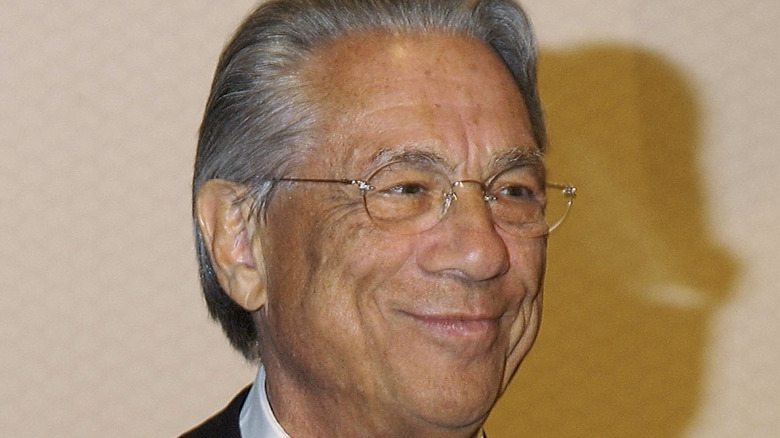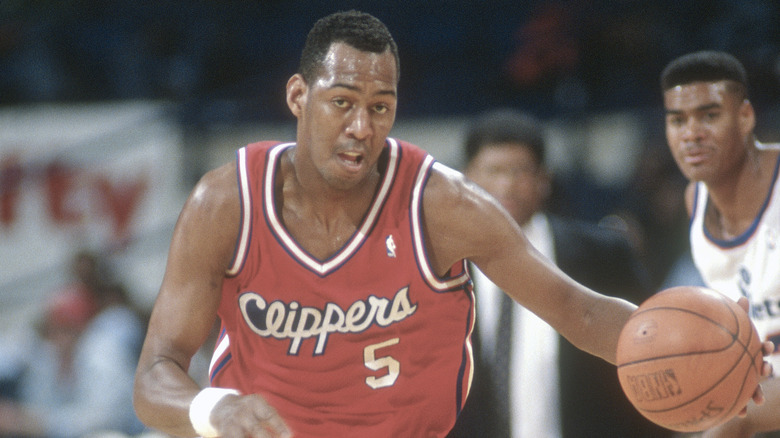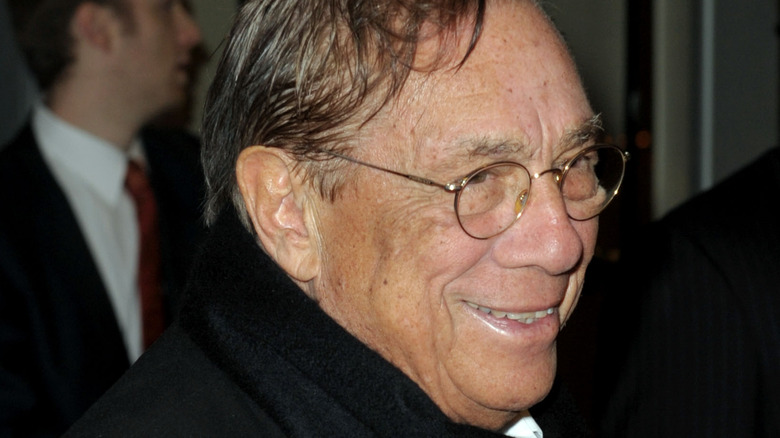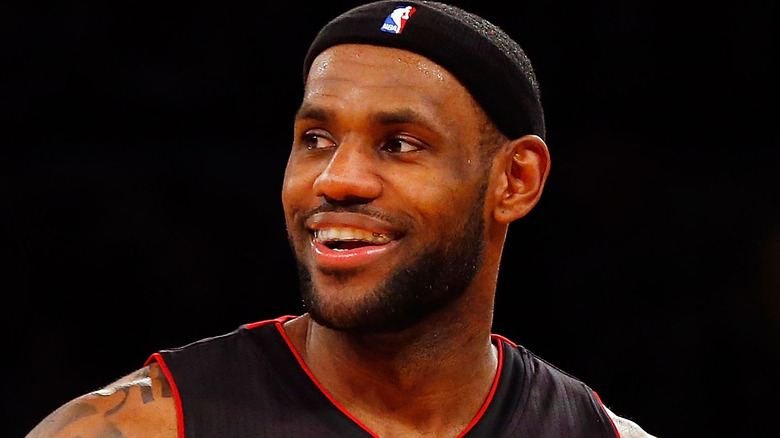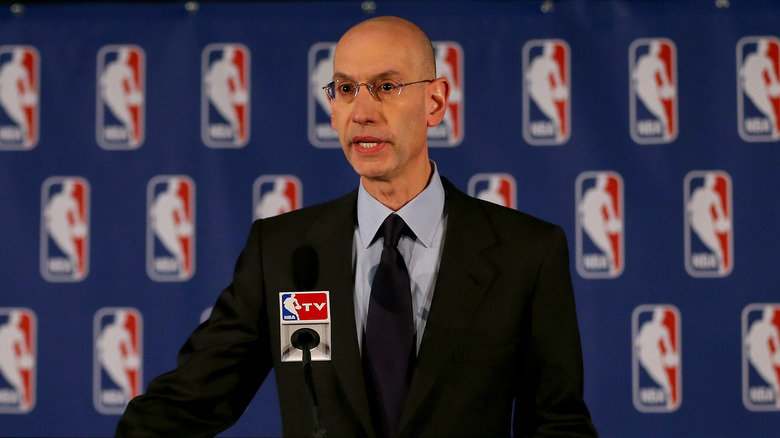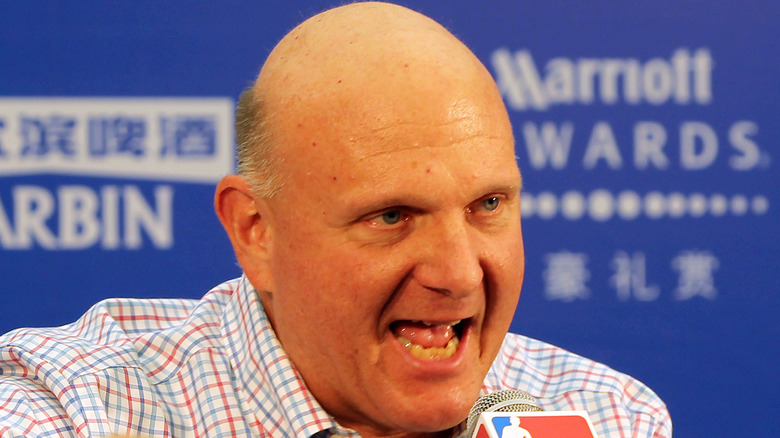How The NBA Ousted Donald Sterling From The Sport
In the world of sports, the players are the people that fans come to see. The coaches are responsible for calling the right plays and ensuring all their players function in-game as a well-oiled machine. The general managers work behind the scenes, swinging trades, deciding on draft picks, and considering free agents to sign. But when everything's said and done, it's the owners that hold the power — they greenlight personnel moves, pay everyone's salaries, and oversee so many other seemingly mundane things that are nonetheless important to their teams' success ... or lack thereof. And when it comes to NBA owners, few are as infamous, unpopular, and controversial as former Los Angeles Clippers owner Donald Sterling.
At the time of writing, it's been close to a decade since Sterling last owned the Clippers. But with FX having recently picked up a series called "The Sterling Affairs," viewers will soon revisit his final years as Clippers owner, with Ed O'Neill — arguably best known for playing the boorish Al Bundy on "Married... with Children" — playing the role of the titular former sports team owner (via Variety). But what exactly was the scandal that resulted in Sterling losing control and ownership of the Clippers, and how did the NBA essentially oust him in the wake of this scandal?
The Clippers largely struggled to win with Sterling as owner
Hardcore NBA fans may be familiar with Donald Sterling's track record as the Los Angeles Clippers' owner, but to understand his legacy, one has to start from the beginning, which was back in 1981 when the Clippers were still based in San Diego. Despite promising to keep the team in their erstwhile home city (via The San Diego Union-Tribune), Sterling moved the Clippers to L.A. in 1984 and made a series of baffling or ill-fated draft decisions that held the team back.
For instance, the Clippers used their three first-round picks in 1987 on players who had decent-at-best careers while passing on future stars such as Scottie Pippen, Kevin Johnson, and Reggie Miller. In 1988, they selected Danny Manning (pictured above) first overall — he had a good career but was held back by injuries. And in 1989, their No. 2 overall pick, Danny Ferry, chose to play in Italy instead of slumming it out with Los Angeles' other pro basketball team. (He was later traded to the Cavaliers for Ron Harper and had a middling NBA career, so things did sort of work out for the Clippers.)
The Clippers kept making questionable draft choices in the 1990s (Michael Olowokandi at No. 1 in 1998, anyone?) and the losing continued for the most part. During Sterling's first 25 years as team owner, the organization only made the playoffs three times and went through a whopping 15 different head coaches (via Basketball-Reference).
Sterling's many controversies, including the leaked racist remarks
Although Donald Sterling had developed quite an unsavory reputation as an NBA executive by the time the late 2000s and early 2010s rolled around, a number of allegations made during this timeframe put him in an even more damning light. In 2009, ESPN's Jemele Hill wrote that the Los Angeles Clippers owner "makes Rush Limbaugh look like Martin Luther King Jr." due to his penchant for racially insensitive remarks and actions, and in 2011, Sterling was accused of denying medical coverage to assistant coach Kim Hughes despite the fact he was dealing with prostate cancer. "I contacted the Clippers about medical coverage and they said the surgery wouldn't be covered," Hughes told The Journal Times (via HuffPost). "I said, 'Are you kidding me?' And they said if they did it for one person, they'd have to do for everybody else."
Sterling was also known for fooling around with much younger women, including Alexandra Castro, who was sued by the executive and his wife in 2002 for matters concerning the ownership of a house he allegedly gifted her during their three-year affair. However, it was another ex-mistress, V. Stiviano, who made the headlines on April 25, 2014, when TMZ leaked audio recordings of Sterling warning her against bringing Black people — including no less than NBA legend Magic Johnson — to Clippers games. These remarks, as well as other leaked racist comments, would put Sterling in the hottest water he'd ever been in during his 33 years as Clippers owner.
LeBron James and other NBA stars called for Sterling's ouster
As reported by ESPN's Ramona Shelburne, the leaked Donald Sterling recording soon caught the attention of the NBA's best and most prominent players. The day after TMZ published its expose, LeBron James reportedly told the media that "there is no room for Donald Sterling in our league," adding that commissioner Adam Silver should "make a stand." Two days later, the then-Miami Heat star called All-Star point guard Chris Paul, who along with 2009 first-overall pick Blake Griffin, helped the Clippers finally enjoy sustained success upon his arrival via trade in December 2011. The call was simply to let Paul know that he had someone to turn to if he needed anything amid all the drama, but this was part of a broader plan to make his voice heard about the Sterling issue.
"I didn't really care if any other players spoke out," James said. "I was doing it because I felt like I needed to speak out. I'm still learning. I'm going to give back when I can. There's a group that's going to come behind me. There's a group that's going to come behind those guys. This beautiful game has to continue to flow the right way, and, where I can make an impact, I'm going to continue to do it."
Sure enough, more players took to social media, calling for Sterling's ouster. James' teammate Chris Bosh spoke to ESPN about the importance of "getting the word out," while Kevin Durant, then playing for the Oklahoma City Thunder, expressed disappointment that the nice guy he once met had some very disturbing things to say about Black people.
The NBA finally takes action
As NBA commissioner, Adam Silver was certainly aware of the leaked recordings, and as ESPN noted, he spoke to several people regarding the tapes, including LeBron James, Chris Paul, and Los Angeles Clippers head coach Doc Rivers. Through these conversations, Silver got more insight into how the league should handle its Donald Sterling problem. But with the Clippers' sponsors withdrawing their support for the organization, a decision had to be made — this was no longer a case of a divisive owner with antiquated and racially insensitive views on people of color, but a case of someone who was, as ESPN described him, "bad for business."
On April 29, 2014, Silver made that decision, slapping Sterling with a lifelong ban from the NBA and fining him $2.5 million. According to USA Today, Clippers president Andy Roeser was assigned to take over team operations while Silver worked on convincing Sterling to sell the organization. This was a move that got a lot of support from other team executives and NBA icons such as Magic Johnson and Michael Jordan.
"The central findings of the investigation are that the man whose voice is on the recordings ... is Mr. Sterling and that the hateful feelings are those of Mr. Sterling. The views expressed by Mr. Sterling are deeply disturbing and alarming," Silver told reporters, later adding, "This has been a painful moment for all members of the NBA family."
Steve Ballmer became the Clippers' new owner ahead of the 2014-15 season
For years, Donald Sterling was described as notoriously cheap, a "class clown" among his fellow executives (as an unnamed team owner told ESPN), and of course, a racist individual. Yet he survived myriad controversies and scandals for 33 seasons, only seven of which ended with a trip to the playoffs. And he wasn't going to back down that easily. But even with Sterling's Alzheimer's diagnosis giving his estranged wife, Shelly, a chance to become the controlling Sterling Family Trust's sole trustee, she took stock of the PR disaster her husband' leaked tapes had caused, and she agreed to sell the Clippers to former Microsoft CEO Steve Ballmer for $2 billion. On August 12, 2014, the sale became official.
Since Ballmer took over, the Los Angeles Clippers have been fairly consistent in making the playoffs, only missing the postseason twice over the last eight seasons. It bears mentioning that in the 2021-22 campaign, which saw them barely miss the playoffs, they still finished 42-40 in the regular season despite superstar forwards Kawhi Leonard and Paul George's injury woes. That's still a vastly different Clippers team from the ones that were littered with draft busts and underachievers and run by a man oftentimes named as one of the worst owners, if not the worst, in sports history.
